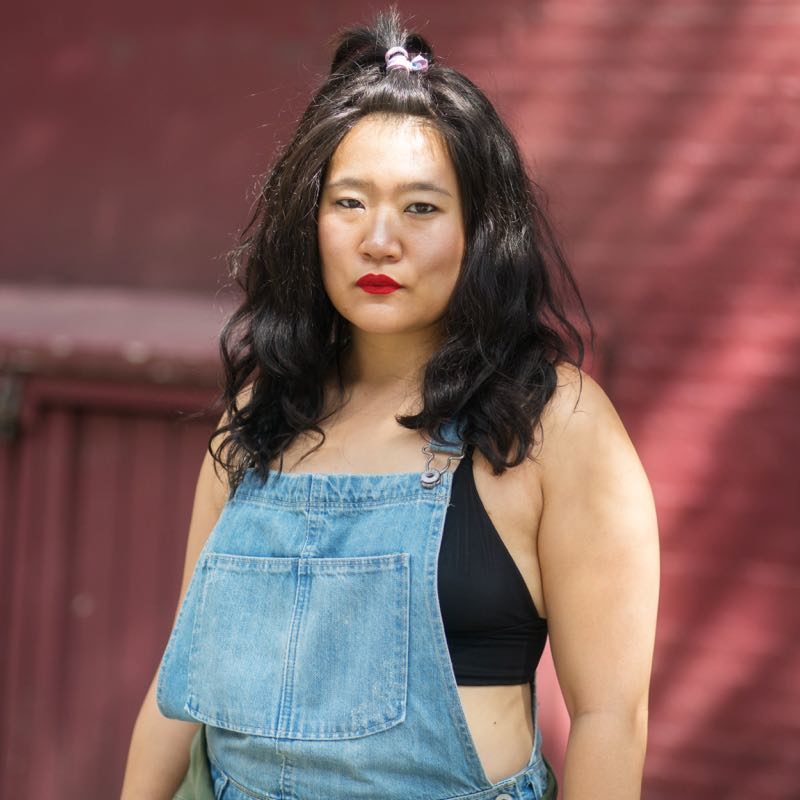Diana Oh on {my lingerie play}
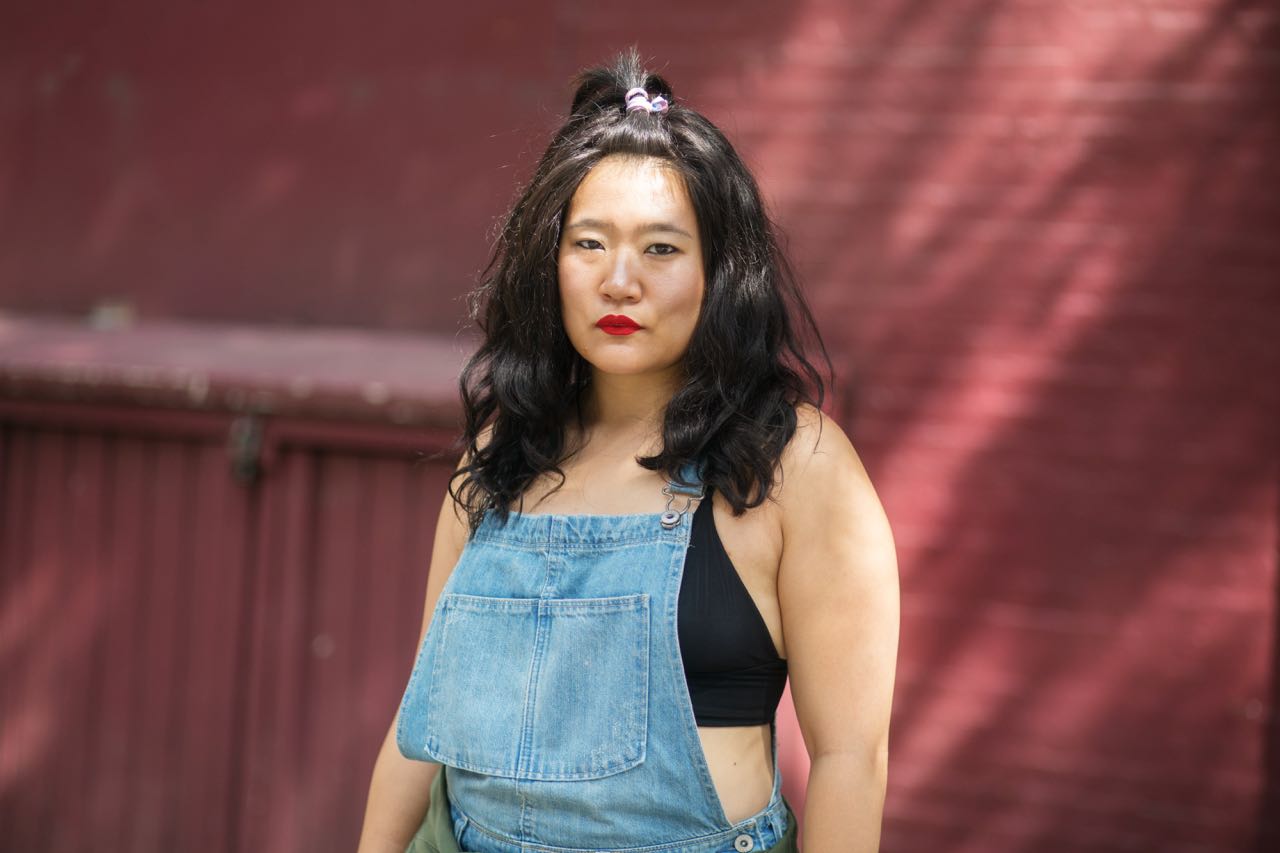
Written by Victoria Myers
Photography by Tess Mayer
October 12th, 2017
As part of Rattlestick Playwrights Theater’s newest season, there is a lot of glitter, all over. This is part of {my lingerie play} 2017: THE CONCERT AND CALL TO ARMS!!!!!!!!! The Final Installation, a concert/theatrical event created by writer/performer Diana Oh. The show started as a series of street installations that featured Diana standing in public in lingerie in an effort to address sexual violence (footage can be found here). The Rattlestick show is a culmination of all of those installations, and is co-directed by Diana and Orion Stephanie Johnstone. We recently spoke to Diana about the evolution of the show and what she hopes audiences will take away from it.
Can you tell me a little bit about how the show evolved?
The piece as a whole began in 2014 as a series of street installations that I started doing in my lingerie holding brown paper bags with messages on them. It was ten underground performance installations and I didn’t know what they were going to be, but I was going to make them up on the spot, and I gave myself the assignment of doing ten of them, blah, blah, blah, blah, blah—and then knowing that it was always going culminate into the concert as the big final thing. So, that started in 2014 and that’s when the language for the piece was, “ten underground performance installations stationed in effort to provide a saner, safer, more respectful world for women to live in.” And then we did the concert a bunch of times in different venues—at Joe’s Pub and EST and this company called All for One—and then in 2016 I met Daniella Topol, who’s the director of Rattlestick, and she had me come in for their New Songs Now series. And I just came in and I did some music and all this stuff and she was like, “What work do you have? Tell me everything.” And I just told her about my lingerie play and she was like, “Let’s do it.” Then we got a grant to do all those street installations again in 2017. I was personally in a place of, like, “I’m not ready to jump back into all this.” There was something about the election that was really silencing for me. I was like, “I don’t have the strength to be the voice of something, you know?” But being given this grant and given these deadlines, it was just kind of like, “I will do this.” It was like, what do these street installations mean now? How does the project need to speak to what’s happening now? In 2014, I think it was female-focused with the understanding that all genders can always participate in these street installations. And then, in 2017, it was like I have got to do something to be more accountable to people beyond me. And with the understanding that I’ve always identified as a queer person and as somebody who doesn’t agree with the gender binary. So in 2017, that’s when it became about “ten underground performance installations staged in an effort to provide a saner, safer, more courageous world for women who are trans and non-binary humans to live in.” And changing the language from “more respectful world” to a “more courageous,” one and how these installations can actually help bring about courage.
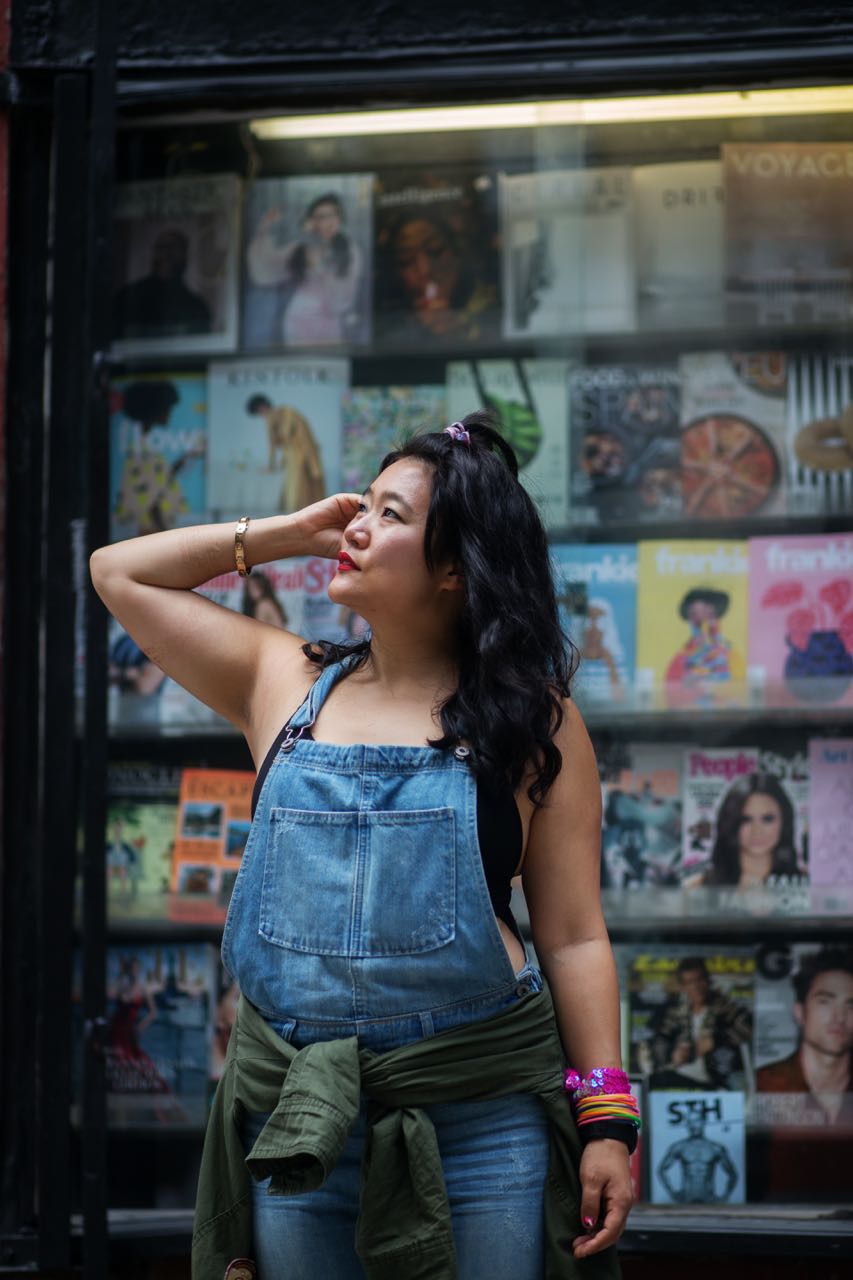
Going back to 2014, what was the initial impetus that went into creating the piece?
The initial impetus was an article I found online. It was written by an anonymous writer where she had just done a photo thing of taking a picture of her lingerie pieces and then would put a little story underneath that was like, “I wore this set for fucking Cliff,” blah, blah, blah, blah, “And then his mom walked in.” And I was like, “That’s so awesome. I want to do that but on stage, and instead of stories it would be my songs.” It would be music that I’d written about these people as somebody who has so much lingerie with so much life in them. Then as I was writing it I was like, “This is bullshit. Because I’m going to write this piece for all the educated theatergoers to come to who will be like, ‘Oh, yes. Don’t treat women poorly. I get it. I’m doing great.’” I was like, “This is a message for the masses, and I have to go do the most massive thing ever.” My roommate found a soapbox outside of our apartment that someone was throwing away, and she was like, “Do you want this thing?” And I was like, “I think I do.” And then the brown paper bags were under the sink and I was like, “I just have to go outside and do this.” So that was it.
Before you changed direction, had you actually written a draft?
I totally did. Because it came out of writing it and being like, “Oh, my gosh. I’m putting all my energy into the wrong thing. I want to do these street installations and I don’t know what that means.” So then I ditched the script and I was like, “I’m just going to do these street installations. I’m going to make them up and it’s going to be like, one, two, three, four, five, six, seven, eight. And then the ninth one is going to be the concert.” Then I was doing the street installations, and then I had about a month to take everything I learned from the street installations and put it in the concert, and then figuring out what the tenth final, final installation was really going to be.
Can you talk a little bit more about how your experience evolved from the first installation to this version? How has the process changed?
I think that the biggest thing is that I’ve changed. I think in 2014 it was coming from a very immediate space. And in 2017 there was time for more reflection and it was time to expose my blind spots, and see that in only talking about the binary of men and women in 2014 I may have hurt people. I may have not included the idea of collective liberation. It just didn’t occur to me. I didn’t know about it then. I kind of knew about it, in that I would say these installations are for all genders, but then in 2017 it was like being exposed to so much in terms of what social justice really means. It made me more unapologetic than ever, but it also made me gender inclusive and really understanding that it’s not just standing up for women. It’s also about standing up for trans and non-binary identities and understanding that the world isn’t split up into man and woman. And that was what really hit me in 2017: there’s men, and then there’s everyone.
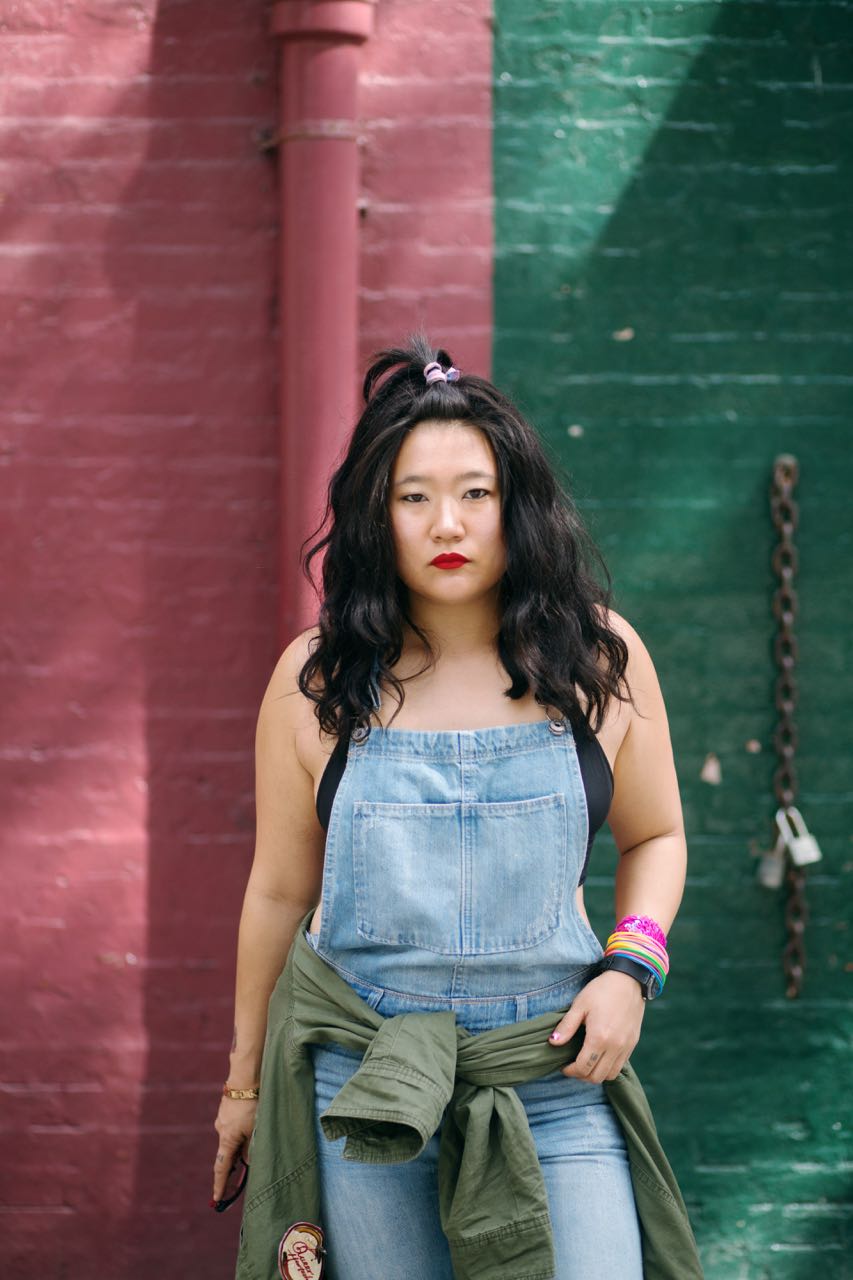
What has the writing and creative process been for putting this together?
Lots of writing and lots of process. It’s just like jumping back into it, because it was doing the installations and a making those up along the way kind of thing. You go and you laser focus in on the installation, and then you come out and you laser focus in on the next installation. Then you come out, and you laser focus on the concert. But the concert is just so huge. We have so many people involved and there’s so much more money involved. And there are so many more opinions to be accountable for, actually—so many more identities and collaborators to be accountable to. And wanting to make sure the work is always centered in the room, which takes more time. It’s just as important as staging. We all have to drop into our hearts and meet each other as human beings before we can be the work. So much of making this concert is very process-oriented, like jumping into your heart-oriented, before we can even get started. But writing it is, you know, you write it. You do it. Everyone gives their notes. You take what you take, you don’t take what you don’t take. You move on, blah, blah, blah. But I really believe in what we’re doing because it feels so heart-centered.
Have you found that it’s been a challenge to come up with the structure of the concert? In terms of taking all the material that you have and then putting it into one evening?
Yes and no. Our guiding principle is—we have this thing in our room that we call community agreements and we read them all together. This is an assignment that Orion, the co-director, asked me to do—write community agreements for the room of what is the space that we are in? What are we agreeing to when we walk into the room? And one of them is I want this piece to tell the truth. Sometimes when I go to see a movie, there are times when I walk in and I feel like I’m being lied to, which is okay. We’re all buying into it. But there’s something about this concert where it’s like, “I don’t want to be lied to. I don’t want to lie and I want it to tell the truth.” That’s always been the guiding principle with all the rewriting stuff. What are we actually saying here and what are we trying to get at? And it’s like, “Well, what is the truth?” Working with our dramaturg [Mei Ann Teo]—who is actually a witch, she’s not a dramaturg—she talks about how every opportunity you have on stage is an opportunity to cast a spell, and what you’re doing is, you’re casting spells, and your audience is in there to get spells cast on them. And we go through this like, “What is this spell here? This song, what do you want this spell to cast?” And just last night I wrote out the set list, but the set list is actually a list of spells so that we’re seeing, “Oh, this is the spell of Fuck Shit Up.” And it’s been really awesome to get to work in that way.
Do you have an example of that? Of how you decided what the spell was and then how you would go about casting it?
I have one that’s called the spell of “Unified Loneliness and Humanity.” This came up because Orion was like, “Well, what do you want this spell to cast at this moment in the show?” And this was in the beginning, and it’s this super crazy, party song. And it’s a song about online dating. It’s just a song about how we’re all lonely and we all want someone to pick me and we all want someone to lift me up, blah, blah, blah. And what it’s really trying to do is get us all, as a room, on the same page of all sharing this in common. We’re all sitting here just wanting to be loved and wanting to love. We seek connection, and that’s what this song needs to just unleash in people: I want to date, I want to be hot, I want you, you want me, let’s go do this. And so it’s big, and people come on stage to dance, and confetti is in the air, and it’s rocking and it’s great.
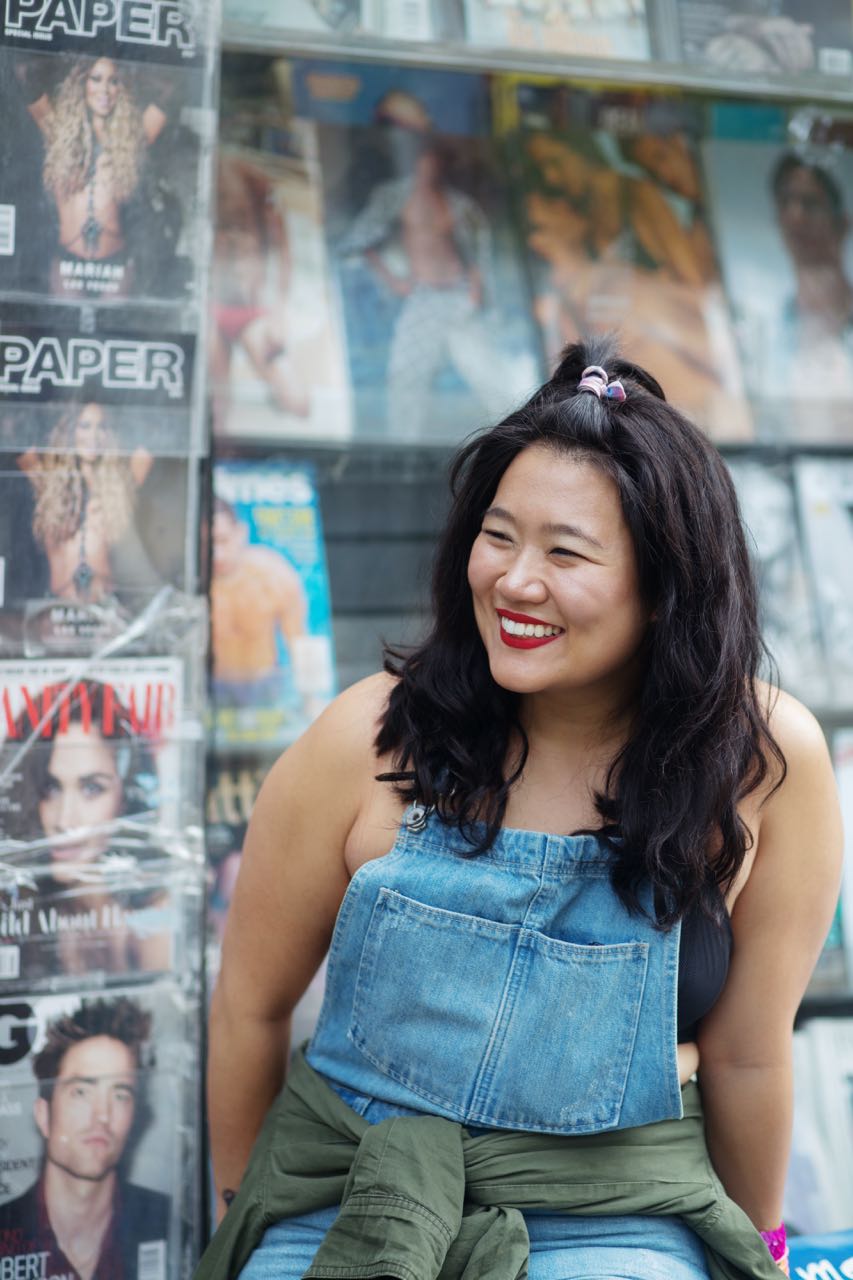
It sounds it would be challenging to develop this piece in any sort of traditional theatrical development process. Has that been your experience or not?
I think because I trust my collaborators so much and they come from such non-traditional headspaces, it’s been so great. Rattlestick and Daniella Topol are so, “We follow the artist’s lead.” So much of it is getting your collaborators together and being able to be like, “This is what we want. This is how we want it. This is how we want to make it.” And Daniella’s so amazing because she’s artist-driven in that way, and she knows that we’re not trying to make the well-made play. The thing that’s been the hardest thing to navigate has been how to keep this concert in the same life source as the street installations that are so radically non-complacent, that are so punk rock. And how do you straddle that line of direct social action and promoting a show and doing a piece of theatre that’s like, “Here’s your ticket, please come. Come to this show.” But it’s actually like, no, this is a sociopolitical action we’re taking to round up people in a room together to make warriors out of us so that we can keep loving harder than we’ve ever loved and fighting for what’s right. And being accountable to each other.
Do you have an example of that?
I think any time any marketing thing goes out or some mass mailing goes out from the theatre, any time a Facebook event is created, it’s making sure that we as a team are rooted in, “Wait, it’s missing this one sentence about how it’s the final installation of all these street installations. Please watch the street installations here on this website.” We’re so involved with all the language behind the show so that it’s less show-focused and more direct action. It was the realization of: we cannot sell the revolution. Nor can we say that we are a revolution. Because the revolution has been happening and we are in the revolution. And what we are is revolutionary. We are contributors to the revolution. And we can’t sell it, but what we can do is share it. And we can ask you to show up. And we can ask you to support it with your presence and with your money, if you have it. But yeah, it’s like we can’t sell this experience but we can share it and speak about it from the heart and get you to come be here and to come see it. Because I like you. Our hearts want to do good in this world. We want to affect you. We want to make your life awesome. And I do feel like this concert can do all that.
What do you hope audiences walk away with from the show? How do you want them to talk about it?
Orion gave us an assignment to think of five different people who come see this concert and to write down what they do right after the concert and then what they do one week from now. We did this whole thing together where it was like, this person comes and she ends up going home with someone, and this person comes and he ends up Googling what trans means. Orion was like, “I think you’re limiting the color of what you’ve created,” and they were like, “Dream bigger.” And it was like, “Okay, I think this person leaves, and then for the rest of their lives they donate a million dollars every single year to a gender-based violence prevention center. And I think this person ends up reforming our entire sex education system in the world because our sex education system in the world is so broken.” There’s a whole line in the concert where it’s like men are taught that their weewee’s can shoot lasers and then women are taught to protect their wombs. And gay and trans people are like, “No wonder we’re such geniuses because we’ve had to make up having sex with each other our entire lives because we never got any education about it in school.” So just dreaming about how this person sees this concert and then goes and reforms the sex education system. The hope is that people connect to each other. That their hearts feel bigger. That they feel more connected to their truth. That they leave feeling accountable to the people in the room. How do we create families out of our audiences? How do we create a heart-centered experience for them as well? And then we’re asking our audiences to come back on October 28th, for the final, final installation, to all come together and meet each other. Everyone’s really angry right now. We’re in this reactionary place right now with how the world is going, and it’s like the only way we can sustain it, actually, is if at the end of the day it all comes from a place of love and empathy.

